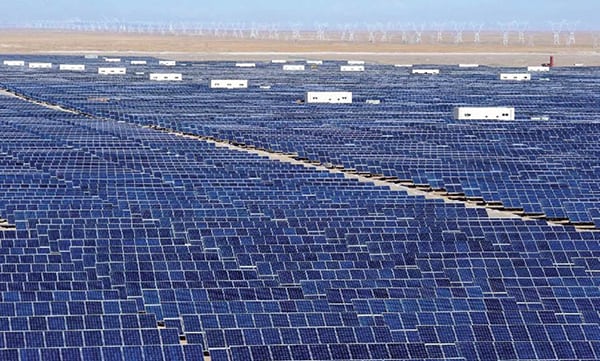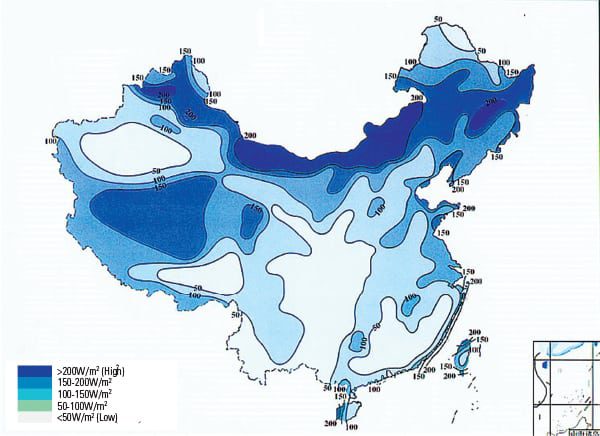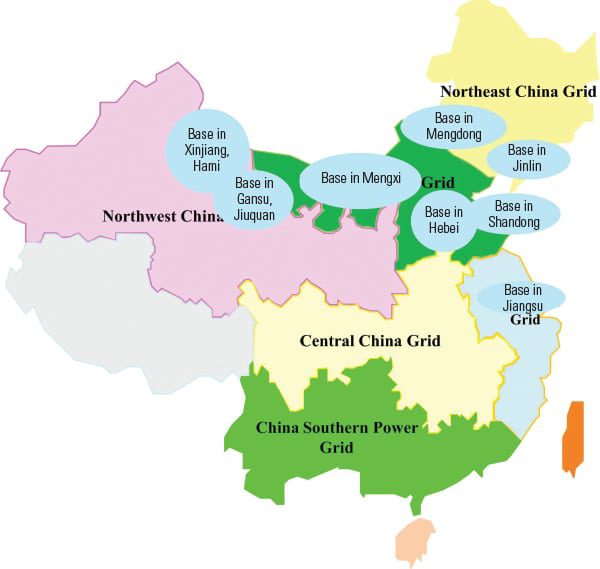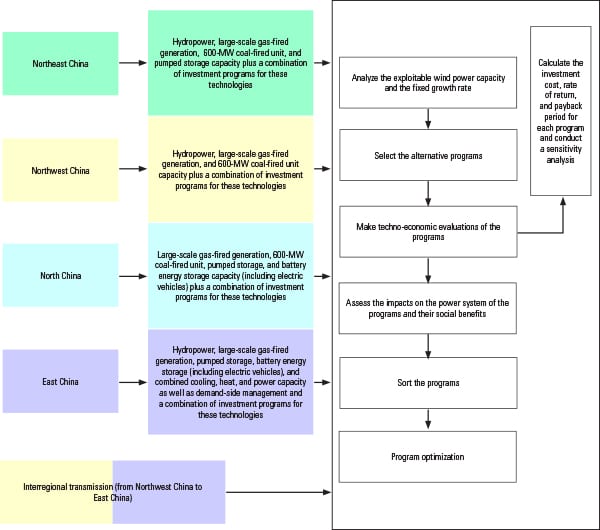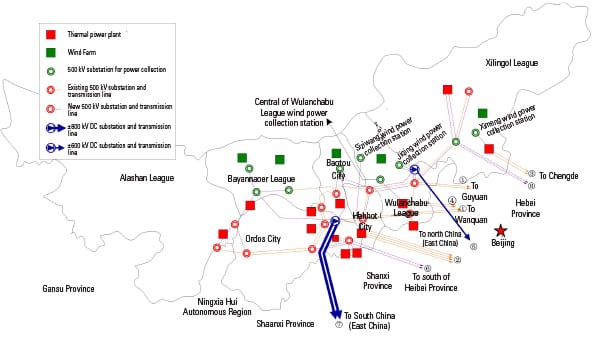A Plan for Optimizing Technologies to Support Variable Renewable Generation in China
Between 2011 and 2015, China plans to add eight major wind generating bases with a total capacity of 65 GW and two solar photovoltaic installations exceeding 10 GW. With all that variable generation planned, the nation must determine how to integrate it into the grid while ensuring grid stability. Researchers from North China Electric Power University propose a plan that takes into consideration the best options on a regional basis.
Recently, the variable generation (VG) industry has been strongly promoted in China to advance sustainable energy development, especially for wind power and solar photovoltaic (PV) power, which have entered rapid development periods. For example, wind power installed capacity in China doubled every year for four consecutive years beginning in 2006, while large-scale solar PV power plants have been integrated with the grid since 2010. But more is to come.
According to the country’s renewable energy development plan, the eight biggest wind power developments will gradually be constructed during the 12th Five-Year Plan period (2011–2015) in Hebei, west Inner Mongolia, east Inner Mongolia, Jilin, Shandong, Jiangsu, Jiuquan, and Hami. The installed capacity of each base may exceed 10 GW, and the total capacity will reach 65 GW. Additionally, two massive PV power bases will be constructed from 2020 to 2030 in Jiuquan and Qaidam basin, each with an installed capacity exceeding 10 GW. Those wind and PV developments are mainly located in Northeast China, North China, and Northwest China, where wind and solar resources are abundant. The Chinese government has issued a series of regulations, such as the Renewable Energy Law, to guarantee renewable power integration.
In China, regions abundant in wind and solar energy are usually remote areas far from load centers and the main grid. Therefore, a current major initiative to solve integration and demand problems is constructing more large-scale transmission lines to enable VG power consumption over a wider area so as to make use of the large-scale and concentrated wind power and solar power bases (Figure 1).
Variable energy sources such as wind and solar have characteristics of randomness, intermittency, and low capacity coefficient. Additionally, local load consumption ability is limited, which challenges the local and region power systems’ safe and stable operation. These problems become more significant as installed wind power capacity increases.
The first problem concerns power system security. Eighty wind turbine tripping accidents occurred in 2010, and 193 wind turbine tripping accidents occurred by August 2011.
The second problem is that wind power is difficult to integrate into networks. The installed capacity of wind power accounted for 3.06%, while power production from wind only accounted for 1.18% of total generation, and this number still hadn’t exceed 2% by the end of 2011.
Construction of large-scale transmission lines could help distribute variable energy over a wider range for more-distant use. Now the primary problem is to determine the optimal supporting technology investment program to back up VG and solve the safety problems posed by VG integration. The determination of peak-shaving power supply type and scale, as well as demand-side management and cross-regional transmission management are involved. Hence, a techno-economic evaluation of VG resource integration supporting technology investment program is needed.
The Technical Roadmap
The approach that we propose has several steps. First, the project would collect relevant available information concerning distribution, installed capacity, and integration of variable power. Then it would analyze the difficulties and challenges with VG integration from a technical level. Next, we propose possible supporting technology investment programs and make techno-economic evaluations of them. Finally, we would sort the various programs according to assessment results, make final optimized decisions, and make recommendations for relevant state policies.
The project collects data by referring to information disclosed by the departments in charge, such as the Bureau of Statistic in China and China Electricity Council. Data needed here mainly concern wind power, solar power, and hydropower distribution; variable power installed capacity and on-grid energy; VG integration in each region; and the relevant supporting technology parameters.
Analysis of VG Integration Challenges
As a research basis for determining appropriate supporting technologies for VG integration, we first analyze difficulties and challenges posed by integrating VG into networks from a technical level. After collecting data—including grid operation data, peak and valley differences and peaking power units data before wind power was integrated into networks—we can analyze the impacts of wind power on system operation from the following angles.
Wind Power’s Impacts on Grid Voltage Level. First we plan to study the geographical and temporal distribution characteristics of VG and energy demand, so as to make clear the impacts on grid voltage of large-scale variable power integration. Existing data show that the wind energy resource and energy demand are distributed in a reverse direction. That means that large volumes of wind power would need to be transmitted long distances to load centers for consumption, which may cause great voltage dips, followed by local grid instability and reduced stability margin. In turn, grid voltage stability limitations also restrict the maximum installed capacity and output of wind farms.
Wind’s Impacts on Grid Short-Circuit Current. Wind power units with common asynchronous generators or doubly fed induction generators are widely used in Chinese wind farms, which affects short-circuit current in a different way from traditional synchronous generators when there is a short-circuit fault on the grid. In this phase, we would analyze the influence of the integration of common asynchronous generators and doubly fed induction generators on grid short-circuit current through field research.
Wind’s Impacts on Grid Power Quality. Wind speed fluctuation is quite obvious in Northwest China, especially on the Tibetan Plateau. We would take the Northwest Grid as the example to analyze the output power fluctuation of integrated wind power units resulting from the random fluctuation of wind speed as well as the turbulence, wake effect, and tower shadow effect during wind power units’ operation. Power quality problems such as voltage fluctuation and flicker would also be analyzed.
Wind’s Impacts on Grid Stability. To study this issue, we would take the Northwest Grid, which has high wind power capacity as an example, studying the impacts that wind power integration has on original power flow distribution, line transmission power, and system inertia. When analyzing the influence of wind power integration on grid transient stability and frequency stability, we will discuss its effects on main grid voltage stability.
Wind’s Impacts on Equivalent Peak and Valley Difference. When studying wind power integration, we could consider wind farm output as negative load. Therefore, we could get the equivalent diurnal load curve through associating the diurnal variation curves of wind farm output and load, so as to observe the peak-valley variation. In this analysis, we take typical days in Baicheng in Jilin Province, which belongs to the Northeast Grid, and in Shaanxi, Gansu, Qinghai, and Ningxia, which belong to Northwest Grid as examples to analyze net load (load minus wind power production) peak and valley difference changes, impacts on peaking power and frequency modulation, and grid operation cost changes.
Wind’s Impacts on Regional Power Grid Peak Shaving. Existing local units are mainly used in China for peak shaving. Relevant standards regarding interregional load trading and settlement are absent in China so far. In this analysis, we first would analyze hydropower, large-scale gas-fired generation, fast-response coal-fired units, and pumped storage plant installed capacity and the roles they each play in peak shaving.
At the same time, considering that wind power is mainly concentrated in North China (which suggests peak-shaving resources such as cogeneration units should also meet users’ heating demand in winter), we will take northeast areas as examples, analyzing impacts on regional power grid peak shaving while integrating large-scale wind power into networks on winter nights.
Wind’s Impacts on the Entire Grid Network. Wind power integration in China now is of large scale, long distance, and high voltage. With the development of even more wind farms, wind power accounts for an increasingly larger percentage of installed capacity, and its influence on the grid is expanding from partial regions. Consequently, we plan to conduct a statistical analysis of wind power installed capacity integrated into distribution and transmission networks. Then we would assess impacts on overall grid security and stable operation while wind power is integrated into the grid through transmission networks.
Requirements for Demand-Side Management and Interregional Transmission. Considering the energy distribution characteristics and the development of large-scale variable energy resources in China, it’s urgent to improve interregional resource allocation optimization ability and to enhance demand-side management (DSM) to achieve interregional transmission. In this phase, we will focus on analyzing the impacts on wind power consumption and energy utilization efficiency enabled by DSM enhancement and interregional transmission. We will also study the necessity of DSM and interregional transmission for VG integration.
Techno-economic Evaluation of Technologies to Support VG Integration
During the 12th Five-Year period, the eight biggest wind power bases will gradually be constructed in Hebei, west Inner Mongolia, east Inner Mongolia, Jilin, Shandong, Jiangsu, Jiuquan, and Hami. The installed capacity of each base may exceed 10 GW, and total capacity could reach 65 GW. Bases in Jiangsu and Shandong will mainly focus on offshore wind power development. The distribution of wind resources in China is shown in Figure 2; distribution of the eight largest wind power bases is shown in Figure 3.
After analysis of the difficulties and challenges posed by grid-integrated variable generation and initial investigation of the distribution of wind resources and load, we could address those challenges by developing four typical planning programs: Northeast China (high wind power, low load), Northwest China (high wind power, lower load), North China (high wind power, high load), and East China (high wind power, higher load).
Heilongjiang, Jilin, Liaoning, and east Inner Mongolia are included in Northeast China, which is abundant in hydropower with low local load. Xinjiang, Gansu, and west Inner Mongolia are included in Northwest China, which is rich in coal, with low load level as well. North China contains Hebei, Shandong, and Jiangsu and possesses a certain amount of pumped storage resource with high local load. Zhejiang and Shanghai are in East China, rich in pumped storage resource with rather high local load.
Based on both national and international research sources, we determined that technologies supporting VG integration in China mainly consist of hydropower, large-scale gas-fired generation, 600-MW coal-fired units (now coal-fired units under 300 MW capacity are shut down to meet the requirement of energy conservation and emission reduction, which makes 600-MW coal-fired units the main peak-shaving resource), pumped storage plants, battery energy storage technologies (including electric vehicles), distributed generation technologies, DSM, and interregional transmission technology.
It is important to note that already-installed capacity of technologies supporting VG integration and wind power capacity is not considered here; we only consider newly added future capacity.
A flow chart of the techno-economic evaluation of technologies supporting VG integration in China is shown in Figure 4.
Brief discussions of specific considerations for each region follow. For each region, the techno-economic evaluation of the proposed technologies involves five steps:
We begin by analyzing the exploitable wind power capacity in the region and determine the capacity of the backup technology needed per MW of grid-integrated wind power. We also look at construction and maintenance costs for the technologies used to support VG integration.
Based on the wind power development plan, we assume that newly added wind power capacity increases at a fixed growth rate, and we evaluate a number of investment programs based on the technology options for each region.
We calculate the initial investment cost of the selected programs, the rate of return, and payback period under existing tariff and settlement systems through techno-economic evaluation theory and methods. Additionally, we will make sensitivity analysis of those investment programs.
We will evaluate the impacts on system operation, equivalent peak and valley difference, and peak shaving by those investment programs. Social benefits also need to be evaluated, especially the energy conservation and carbon emissions benefit.
We will make a comprehensive evaluation of the total investment cost, internal rate of return, payback period for investment, and social benefits. Considering that there is a national sustainable development plan for energy utilization and that tax incentive measures may be issued, we will only consider the relevant investment programs in this phase.
Northeast China. Considering resource distribution characteristics, uneven load distribution, and the low load in Northeast China, we select four VG integration supporting technologies for techno-economic evaluation: hydropower, large-scale gas-fired generators, 600-MW coal-fired units, and pumped storage.
Northwest China. Considering resource distribution characteristics, the area’s richness in coal and water resources, uneven load distribution, and lower load, we select these three VG integration supporting technologies for techno-economic evaluation: hydropower, large-scale gas-fired generators, and 600-MW coal-fired units.
North China. Considering resource distribution characteristics with the absence of a large coal power and hydropower base, even load distribution, and high load level, we select these five VG integration supporting technologies for techno-economic evaluation: large-scale gas-fired generators, 600-MW coal-fired units, pumped storage, and battery energy storage technologies (including electric vehicles).
East China. Considering resource distribution characteristics with rich water resources, even load distribution with high load level, and the region’s high dependence on cross-province transmission, we select these six VG integration supporting technologies for techno-economic evaluation: hydropower, large-scale gas-fired generators, pumped storage plants, battery energy storage technologies (including electric vehicles), and CCHP (combined cooling, heating, and power).
Evaluation of Interregional Transmission Technology Programs
In China, regions that are abundant in wind and solar energy usually have low load levels (for example, the Northwest Grid). That combination contributes to limited ability for local energy consumption, wind power abandonment, and low energy utilization efficiency. A smart grid with an ultra-high-voltage grid as its backbone network is being built in China to achieve VG integration via large-scale interregional transmission over long distances with high efficiency to enable remote consumption—typically, in East China (Figure 5).
In considering this challenge, we will propose an interregional transmission plan considering relevant issues to improve VG consumption levels and increase energy utilization efficiency. We will also take the ultra-high-voltage transmission line from Northwest China to East China as an example to evaluate possible economic and environmental benefits.
From Evaluation to Implementation
After comprehensively assessing the results of the techno-economic and social benefit evaluations of the various technology options for supporting VG integration in each region, and accounting for renewable energy policies and their trends, we will select and propose the preferred investment plan for VG integration supporting technologies in each region.
As investors are usually encouraged by economic interests, we should make investment decisions according to each program’s techno-economic evaluation results. For programs economically viable and with good social benefits, the government should support market-oriented investments, while the government’s main duty is to conduct market regulation.
As to programs not economically viable but with good social benefits, the government should introduce incentive measures—such as tariff compensation, direct subsidies, or preferential loans—to support investments. Programs economically viable but with poor social benefits could be treated as options. Programs not economically viable and with bad social benefits should be abandoned.
Goals and Impacts
If this project is successfully implemented as outlined here, the project is expected to have three main benefits.
First, it could provide a decision-making basis for the Chinese government that could help it determine the appropriate combination of technologies for supporting VG integration and their capacity when a certain amount of wind power is put into production. That could contribute to maximizing the amount of grid-integrated VG.
Second, it could provide an investment decision-making basis for players in the market and help improve investment efficiency.
Third, mature experience concerning large-scale and concentrating VG exploitation and long-distance transmission is absent at present. If this project is successfully implemented, the research results can provide a reference for other countries. ■
— Zeng Ming, Li Shulei, and Xue Song ([email protected]) are all with North China Electric Power University, Beijing. The work described in this article was supported by National Science Foundation of China (NSFC) (71271082), The National Soft Science Research Program (2012GXS4B064), and The Energy Foundation (G-1006-12630).
